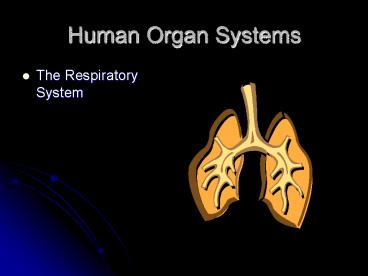Human Organ Systems - PowerPoint PPT Presentation
1 / 13
Title:
Human Organ Systems
Description:
Human Organ Systems The Respiratory System Function The respiratory systems main job is gas exchange. The respiratory system supplies your body with oxygen needed for ... – PowerPoint PPT presentation
Number of Views:228
Avg rating:3.0/5.0
Title: Human Organ Systems
1
Human Organ Systems
- The Respiratory System
2
Function
- The respiratory systems main job is gas exchange.
- The respiratory system supplies your body with
oxygen needed for respiration. - The respiratory system also works to remove CO2
gas.
3
Function cont.
- Your respiratory works with other organ systems
to help you maintain homeostasis. - Digestive and Circulatory Respiratory system
works with these two systems to provide the raw
materials for cellular respiration. - Excretory system The respiratory system aids in
the removal of metabolic wastes CO2 and H2O
4
Components
- Nose Nose is the primary entry and exit site of
gases in the body. Mucous and Cilia (fine
hairs) help to moisten and filter the air you
breath. - The air is also warmed as it passes through your
nasal passageways. - Mouth Secondary entry and exit site for gases.
Important especially during physical exertion
when the body needs more O2 and is producing more
CO2.
5
Pharynx, Larynx and Trachea
- Once the air leaves your nose or mouth, it next
travels into your Pharynx (Throat). - The air then travels past a protective flap on
tissue called the epiglottis, and the air passes
through your larynx (Voicebox) - Next the air passes into your trachea (windpipe)
- The trachea carries the air into your lungs.
6
Lungs
- Another important component of the respiratory
system are the lungs. - The lungs are lobed air sacs that are found in
the thoracic cavity. - The right lung has 3 lobes, the left lung has 2.
- They are surround by a thin membrane called the
Pleura.
7
Air vessels
- You trachea splits off into two large air tubes
called the left and right Bronchi. - The bronchi branch off to form smaller tubules
called bronchioles - The bronchioles get even smaller and end up in
small grapelike bundles called alveoli. - It is at the alveoli that gas exchange occurs.
8
A two-way street
- Unlike your digestive system, your respiratory
system only one point of entry and exit. - Air flows into your body is this order.
- Nose or mouth ? Pharynx ? Larynx ? Trachea ?
left or right bronchi ? bronchioles ? Alevoli. - It leaves your body through the same structures
just in reverse order.
9
Air pressure
- The air flows into and out of your lungs due to
differences in air pressure inside and outside
your lungs. - Every breath you take has two components, an
inhalation, and an exhalation. - Inhalation requires energy while exhalation does
not.
10
I never inhaled B. Clinton
- When you inhale, a large muscle located at the
bottom of your lungs called the diaphragm
contracts. - When the diaphragm contracts, it pulls downward
on your lungs, causing them to increase in
volume. - As volume is increased, the air pressure inside
you lungs decreases. - The air moves from high pressure (outside) to low
pressure (inside)
11
Waiting to exhale
- When you relax your diaphragm it allows the lungs
to go back to their relaxed state. - The lungs lose volume which causes the air
pressure to increase. - This increase in air pressure causes the air in
your lungs to be forced out of your body.
12
Breathing summary
- Inhalation Volume of lungs increases, air
pressure decreases, air flows in. - Exhalation Volume of lungs decreases, air
pressure increases, air flows out. - Also aiding in this process are muscles between
your ribs called intercoastals. - The intercoastals help increase the volume of
your lungs by expanding the rib cage during
inhalation.
13
Video
- Lets watch a short video that will give us a good
look at what happens everytime we breathe in, and
breathe out. - Respiratory system video































